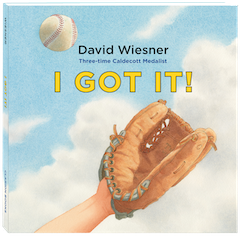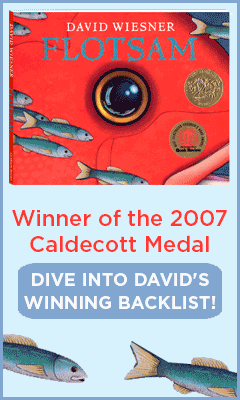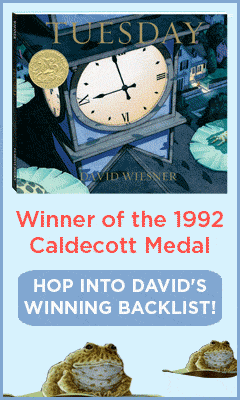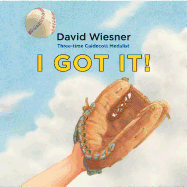I Got It!
by David Wiesner
Three-time Caldecott Medal winner David Wiesner once again brings young audiences a hint of the extraordinary in his new almost-wordless picture book, I Got It!
A child, already wearing his baseball glove, peers nervously through the backstop at a group of kids organizing a pickup game. Hands behind his back, one foot self-consciously placed over the other, he clearly wants to play. He slowly approaches the small group organizing itself on the title page and asks to be included. In a series of three, graphic novel-like panels, an older boy gives our hopeful player a contemplative stare and sends him to the outfield where, against a backdrop of green trees and suburban homes, the boy gets ready to play.
The next thing the reader knows, the opposing team has hit a fly ball in the boy's direction. The page turn shows a close up of him against a blue sky with puffy, white clouds reaching... reaching... "I got it!"
Only he doesn't. The white-bordered illustration on the left-hand page flows seamlessly into the right, on which the boy is shown in a sea of white space, tripping over a large root. A small group of birds stands by as his hat flies off and he goes down, the ball soaring right over his glove. The next full-page spread depicts the boy on the ground, still reaching for the ball, his hat and one shoe lying next to him, his six teammates face-palming at his failure.
The next page turn again shows the boy, nervous face extremely focused as he reaches into the blue sky. Half of the ball is now in view, looking as if it is aiming directly for the center of his glove. Again, there is a seamless transition from the bordered, puffy-clouded real world into the boy's imagination: on the right-hand page, he is shown tripping over a root that looks like something from a Grimm fairytale. The knee-high root is gnarled and accompanied by other sinister-looking roots that are exploding out of the ground. The birds, which had seemed so innocent surrounding the first tripped-over root, now fly menacingly in the white space surrounding the boy. Another page turn to a full-page spread, and the boy has fallen directly into a tree, arms wrapped around it à la Wile E. Coyote.
Back and forth the reader goes, from the boy's real-time reach for the ball to his split-second imagination of the very worst scenario. As the others on his team also reach for the ball, he envisions it suddenly growing to the size of a blimp, looking as if it may crush him as it plunges to the ground. Next, he is shrinking--or his teammates are growing--until he is mouse-sized in relation to the other children. Clinging to the shorts of a teammate, he is propelled through the air as the kids run to catch the ball. He leaps from legs to heads, bounding from hat to hat as he tries desperately to catch it. He and the birds fly between hands and baseball gloves the size of cars as he reaches... reaches....
"I GOT IT!"
Back in the real world, the boy and his team celebrate while the opposing team's hitter laments the catch. Our protagonist has saved the day, and the final page shows him seated on the ground waiting for his turn at bat, smiling as he chats with his new friends.
I Got It! is a depiction of Wiesner's almost lifelong interest in "the idea of a lengthy mental fantasy happening in a very short time." Here, the boy runs through several upsetting fantasies in the few seconds it takes for him to catch the ball heading his way. "The most challenging part of this book," Wiesner said, "was [visually] differentiating the two worlds.... The real-world paintings are framed on three sides by a white border. When the boy reaches for the ball on a left-hand page, the white border and the white clouds in the sky on that page flow into the facing page, where his thoughts exist as isolated forms. It is the border/no border design that carries the reader between the two worlds."
Beyond the border/no border design, Wiesner wanted to heighten the difference between the realistic and imaginary worlds. He painted "the art in two different ways. The real world is done in opaque paints, with acrylic, gouache and watercolor.... The mental scenarios are done with watercolor." This gives the imagined scenes an almost ethereal effect--everything is a little bit softer, a little bit less defined. "When [the boy] ultimately takes control of his thoughts," Wiesner said, "the final mental image has all the other figures fading away."
As can be expected of any David Wiesner work, I Got It! is extremely creative and features bewitching art. Like Tuesday or Mr. Wuffles, the wordless nature of this book allows children (and adults) to experience and interpret the story in any number of ways, giving the gift of countless new rereads. I Got It! is an experience, and readers will surely love the ride. --Siân Gaetano








